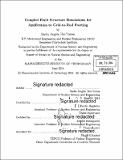Coupled fluid structure simulations for application to grid-to-rod fretting
Author(s)
Tan-Torres, Sasha Angela
DownloadFull printable version (14.17Mb)
Other Contributors
Massachusetts Institute of Technology. Department of Nuclear Science and Engineering.
Advisor
Emilio Baglietto.
Terms of use
Metadata
Show full item recordAbstract
Grid-to-rod fretting (GTRF) has been the major cause of fuel leakage in Pressurized Water Reactors (PWRs) for the past ten years. It is responsible for over 70% of the fuel leaking in PWRs in the United States. The Consortium for Advanced Simulation of Light Water Reactors (CASL) has identified GTRF as one of the "Challenge Problems" that motivates the need for development and application of a modeling environment for predictive simulation of light water reactors. In this thesis, an initial verification of the Fluid Structure interaction (FSI) coupling algorithm for flow inside a vibrating tube was conducted using CFD software STAR CCM+. The benchmark confirmed accurate predictions of the coupled frequencies over a wide range of Reynolds numbers, providing good confidence on the generality of the approach. A representative spacer model was then developed to be used to evaluate the coupling phenomena in GTRF applications. The geometry consists of a 2 span, 3x3 spacer grid. To create the coupled fluid-solid test geometry, a solid Zircaloy cladding was added to the geometry. The solid cladding was added to capture fluid structure interaction effects. The spacer grid supports were altered to mimic having experienced relaxation and allowing free movement of the fuel rod for small displacements. A desirable mesh was constructed over the geometry. Large Eddy Simulations (LES) have been performed to accurately compute the turbulent forces acting on the spacers. Simulations were first performed for a rigid rod, as a reference decoupled solution. Fully coupled simulations were successively performed allowing for the evaluation of the complexity of the fluid-structure coupling behavior. Results of the simulations were also compared to previous Westinghouse analysis performed on a production spacer with a decoupled approach, to confirm the prototypical performance of the geometrical configuration adopted in the present work. The ultimate goal of this thesis was to demonstrate the practicability of a fully coupled FSI simulation for PWR fuel simulations, and further to advance the understanding of the complex fluid structure coupling in PWR fuel assemblies.
Description
Thesis: S.M., Massachusetts Institute of Technology, Department of Nuclear Science and Engineering, 2014. Cataloged from PDF version of thesis. Includes bibliographical references (pages 83-84).
Date issued
2014Department
Massachusetts Institute of Technology. Department of Nuclear Science and EngineeringPublisher
Massachusetts Institute of Technology
Keywords
Nuclear Science and Engineering.